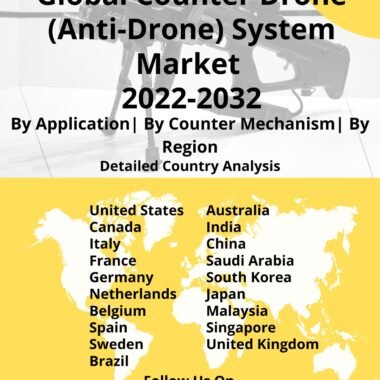Description
Global Cruise Missiles Market
Cruise missiles are sophisticated, guided missiles designed for precise long-range attacks against various targets, including enemy installations, naval vessels, ground targets, and infrastructure. They are characterized by their ability to fly at relatively low altitudes, often hugging the terrain or the ocean surface, and are capable of evading enemy radar detection and air defenses. Cruise missiles are a significant component of modern military arsenals and are used by various nations for offensive and defensive purposes. Cruise missiles are equipped with advanced guidance systems that allow them to navigate and steer toward their target with high accuracy. Inertial Navigation Systems use accelerometers and gyroscopes to measure the missile’s position, direction, and speed. They provide accurate navigation, but their accuracy can degrade over time. Many cruise missiles incorporate GPS receivers to obtain precise position information from satellites, enhancing accuracy over longer distances. Terrain Contour Matching (TERCOM) systems use radar altimeters to compare the missile’s actual altitude with pre-stored digital terrain maps, allowing the missile to fly at low altitudes while avoiding obstacles. Digital Scene Matching Area Correlation (DSMAC) systems use optical sensors to compare images of the target area with stored reference images, allowing the missile to precisely navigate to the target.
Land-Attack Cruise Missiles market analysis are designed to strike targets on land. They are used for attacking military installations, infrastructure, and strategic targets deep within enemy territory. Anti-Ship Cruise Missiles are optimized for attacking naval vessels. They often include advanced targeting systems to detect and home in on ships. Submarine-Launched Cruise Missiles (SLCMs) are cruise missiles launched from submarines, providing stealthy and covert strike capabilities against both land and naval targets. Air-Launched Cruise Missiles (ALCMs) missiles are launched from aircraft, extending the strike range of the launching platform. Ground-Launched Cruise Missiles (GLCMs) are launched from mobile ground platforms, providing a versatile land-based strike capability.
Cruise missiles market trends can travel hundreds to thousands of kilometers, allowing attacks on distant targets without putting pilots at risk. The guidance systems enable accurate targeting, reducing collateral damage and increasing mission success rates. Low-flying and terrain-hugging flight profiles make them difficult to detect and intercept, enhancing their survivability. They can be launched from various platforms, including ships, submarines, aircraft, and ground vehicles. With advancements in warhead technology, cruise missiles can carry various types of warheads, including high-explosive, bunker-buster, and even nuclear warheads.
Major factors driving Cruise Missiles Market Growth
Many countries were investing in the modernization and upgrade of their military capabilities, including cruise missile systems, to maintain a competitive edge in modern warfare scenarios. Ongoing geopolitical tensions and conflicts in various regions were driving the demand for advanced weaponry, including cruise missiles market growth, as nations sought to enhance their defense capabilities. Advances in anti-ship cruise missile technology were driving navies to upgrade their naval warfare capabilities, leading to increased procurement of anti-ship cruise missiles for both offensive and defensive purposes.
Trends influencing the Cruise Missiles Market Size
The concept of multi-domain operations, which involves the integration of capabilities across air, land, sea, space, and cyber domains, was driving the demand for cruise missiles capable of operating in diverse environments. Advances in propulsion, guidance, and targeting technologies were enhancing the capabilities of cruise missiles market size, making them more accurate, longer-ranged, and capable of evading enemy defenses. The development and acquisition of submarine-launched and air-launched cruise missiles were boosting the demand for these platforms as submarines and aircraft continued to play crucial roles in modern warfare.
Cruise Missiles Market Forecast & Dynamics
The global cruise missiles market forecast was expected to experience moderate to steady growth due to several key factors shaping the defense industry. The increasing demand for precision strike capabilities, geopolitical tensions, and advancements in missile technology were driving this growth. The market encompassed various segments, including land-attack cruise missiles, anti-ship cruise missiles, submarine-launched cruise missiles, and air-launched cruise missiles.
Cruise-Missiles Market Analysis for Recent Developments
A land assault cruise missile was fired in a test by the Taiwanese military. The missile is a counter-strike weapon with a baseline and expanded range that can hit the Chinese mainland. The extended range can reach targets at distances of 1,000 to 1,500 kilometers (621 to 932 miles), whereas the baseline version has a stated range of 300 to 600 kilometers (186 to 373 miles). Its warheads apparently contain powerful explosives of the 1,000 and 440-pound classes that can pierce solid targets. Inertial navigation system guiding and terrain contour matching capabilities are purportedly used by the HF-2E. The latter increases its navigational accuracy and enables it to fly at a low altitude to avoid hostile defenses.
The Market is a key player in shaping modern military capabilities, and responding to evolving security threats and geopolitical dynamics. Cruise missiles, known for their precision, long-range capabilities, and ability to deliver varied payloads, are in high demand as nations seek versatile and effective tools for strategic deterrence and military operations. The market is experiencing significant growth due to the continuous development and deployment of advanced cruise missile systems by various countries. Technological advancements are prominent within the market, with a focus on improving navigation systems, target acquisition, and stealth capabilities. The integration of artificial intelligence, advanced sensors, and autonomous features enhances the effectiveness and versatility of cruise missiles, making them capable of navigating complex environments and evading enemy defenses.
Collaborations between defense contractors, technology developers, and military agencies are driving innovation and competition within the cruise missiles market report. As countries invest in modernizing their defense capabilities, the Global Cruise Missiles Market in 2023 underscores the importance of precision-strike capabilities in contemporary warfare. The market reflects a strategic commitment to maintaining military superiority, deterring potential adversaries, and ensuring a robust defense posture in the face of diverse and dynamic security challenges worldwide.
Key Companies





